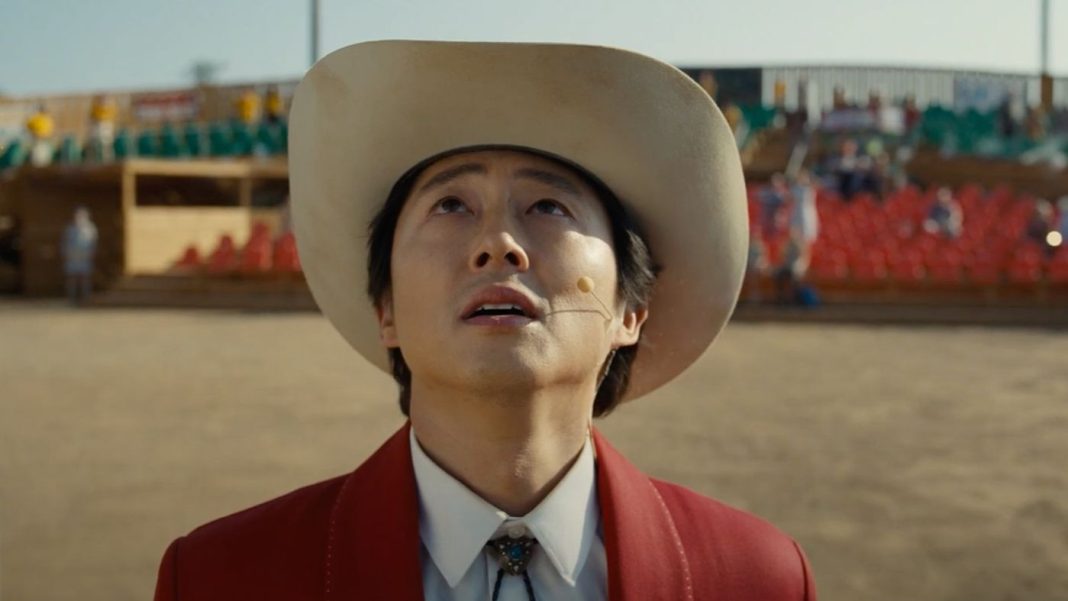Every now and then, a film comes along that defies everything that came before. When Jordan Peele’s Get Out released in 2017, it wasn’t a film that drew immediate comparison to predecessors. Rather than being a this-film-meets-that-film-with-a-twist-of-this-other-thing, Get Out was the singular kind of of-the-moment film that created its own derivatives.
It’s an incredible, if not impossible, starting point for a director, and one continued by his follow-up, Us. Fans of Peele’s are likely, then, to be surprised by his newest effort, Nope. Jaws, Tremors, Close Encounters of the Third Kind, Signs – it’s easy to throw around big-name blockbuster comparison points for Nope, which might be the biggest twist of them all for a film wrapped in puzzle-box trailers. Instead of creating something wholly novel, Peele creates his most technically ambitious film yet by following in the treads of and paying homage to classic blockbusters.
Nope opens with two seemingly unrelated events: the aftermath of a deadly animal attack on a 90s sitcom set, and a dangerous rain of small metal objects falling from the sky. Through the 2-ish hours that follow, the film slowly unravels the connections between these events and the people who experienced them. One of those people is OJ Haywood (Daniel Kaluuya), who runs a family business of training horses and renting them out for film stunts. OJ and his sister Emerald (Keke Palmer) are already struggling to keep the family business going when a series of strange events begin to plague their family ranch. What’s a bad miracle, he asks his sister – they got a word for that?
Nope.
It’s not a big reveal, if you’ve seen the trailers, to say the bad miracle that haunts the Haywoods takes the form of an unidentified flying object. But this isn’t your run-of-the-mill save the earth from annihilation kind of sci-fi film. Instead of trying to kill or befriend or “beat” the aliens, OJ and Emerald become hell-bent on capturing photographic evidence of this flying phenomenon. This time, it’s not federal agents in black suits swirling around the periphery of the plot and threatening to seize control from our protagonists, but paparazzi wielding video cameras. It’s a fairly straightforward subversion of the genre, but one that feels somehow more socially relevant. Throughout their efforts to capture the UFO on film, Nope explores the way film and social media have monetized the nature of relevance, and even the act of experience. Digital discovery remains the last great frontier.
Horror as a vehicle for processing trauma and framing societal ills is nothing new, but the number of A24-styled horror vehicles populating screens over the last few years has become overwhelming. So it was a refreshing change to see Peele stretch himself into a new and different style of filmmaking, fueled by his biggest budget yet and powerhouse cinematographer Hoyte van Hoytema.
And once again, Peele’s film comes at a critical moment that feels almost supernaturally precognitive. As Disney and other studios pivots towards streaming vehicles and middling blockbuster fare and the world continues to wrestle with a pandemic that just won’t stop, theaters face a question of life or death. Nope joins a slate of films this year like Top Gun: Maverick, Everything Everywhere All at Once, and presumably the forthcoming Avatar 2, that make a case for the movies-as-a-thrill-ride argument, one that demands as big a screen as possible.
Though Nope effectively evokes and even revives the kind of big, unfettered IP blockbuster we’ve all been missing, it doesn’t do so without a few rough edges, the primary one being that of editing. The way the film is woven together enhances the feeling of mystery around it, but that mystery is sometimes detrimental. There are at least 2 or 3 minor plot points that became bigger questions in my mind, not because they were important, but only because they way they were shown on screen led to unnecessary confusion. And although Palmer is the bright standout in an overall solid cast, Kaluuya’s intentionally understated performance in the role of OJ doesn’t always feel big enough to match the kind of massive blockbuster he’s in. And lastly, the ensemble of supporting characters also feels a little unbalanced, with Steven Yeun’s Ricky sometimes threatening to steal the show, and other characters, like Brandon Perea’s Angel, feeling paper-thin.
Still, I’d consider Nope to be a big swing and a solid hit. It’s a pure white-knuckle form of spectacle and thrill, enveloping its audience in its sweeping cinematography, immersive sound design, and haunting score. That it can graft some clever commentary on top of this vehicle without being bogged down in metaphors and meaning, something I’d argue was a detriment to Us, is an exercise in the art of restraint.
From a filmmaker as innovative as Peele, a big-budget sci-fi blockbuster almost feels like a risk, particularly given the industry’s approach of handing IP like Star Wars to up-and-coming filmmakers and then seizing control back when things don’t go as planned. With Us, Peele successfully made the transition from one-hit-wonders to directors with a cemented style and brand. With Nope, Peele is on the verge of joining a small and exclusive club of directors whose own names, rather than that of decades-old characters, are enough to pack a theater.








I thoroughly enjoyed “Get Out”, and just as enthusiastically dismiss “Us” as not recommended viewing.
So, I “hope” that “Nope” will see Peele delivering an enjoyable, recommendable film experience!
Comments are closed.